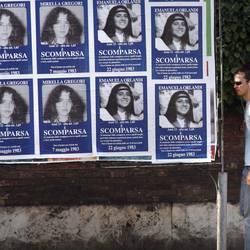" in the Vatican There Are Those Who Know Where Emanuela Orlandi Is but Will Not Talk"
By Giacomo Galeazzi
The Public Prosecutor of Rome: "De Pedis' tomb will not be opened" A three-decade-long wall of silence is crumbling. The investigators will not open the tomb of the boss of Magliana, Renatino De Pedis, at Sant'Appollinare but they are convinced that "the Vatican knows the truth about Emanuela Orlandi." It sounds like a scene out of Italian TV drama Romanzo criminale (a series about organized crime in Rome in the 80s), but it actually happened. For the first time, magistrates are explicitly pointing the finger at the Holy See. According to the Assistant Public Prosecutor, Giancarlo Capaldo and Deputy Prosecuting Attorney Simon Maisto, someone in the Curia is allegedly in possession of "elements of truth that are circumstantial evidence." The Cardinals (Re, Martinez Somalo, Silvestrini) who, under the pontificate of Karol Wojtyla, occupied key positions at the time of the disappearance of the papal emissary's daughter, could be heard in court. An unexpected speeding-up of events. One of the most complicated and celebrated "cold cases" in the world has suddenly turned into a tear in the fabric of half-admissions, false trails or improbable tracks. This flash in the dark has become a nightmare for the family and an international intrigue with claims of ghostly acronyms, interlaced with the attempt on John Paul II's life and the suspicions regarding the head of the IOR, Paul Marcinkus. According to Pietro Orlandi, the brother of the girl who vanished 29 years ago, this is a pivotal moment. "The declaration by the prosecutors that the truth is known in the Vatican is very heavy, but it's overshadowed the strange decision not to open De Pedis' grave," Peter Orlandi says. "If two years ago, the prosecutor ordered DNA samples of us family members to be collected, it meant that there is a valid reason to inspect Sant'Appollinare; it's unclear why now that act is no longer useful to the investigation." Probably "the prosecutors know the names of these Vatican figures, I hope that they listen to them to find out what they know." However, "implicating the Holy See directly, as the attorneys have done, is a huge step forward," says Peter Orlandi. "Now the Holy See has a moral duty to give a response after years of refusing to cooperate with the magistrates," Orlandi specified. Before Christmas I brought a petition with 80,000 signatures to Fr. Georg, Benedict XVI's secretary and this had an effect." Three years ago, Cardinal Agostino Vallini, Benedict XVI's vicar in Rome, gave the "nulla osta" or clearance to open De Pedis' tomb. Meanwhile, Renatino's figure lingers in the background. And it is precisely the burial place of De Pedis, killed in Campo de' Fiori in an ambush on February 20, 1990, which cast on the event ulterior, disquieting shadows, causing scandal. It all started with a phone call on the 2005 broadcast, Chi l'ha visto?(an Italian TV series on missing persons). An anonymous voice (according to a report in 2010, that of Carlo Alberto De Tomasi, son of "Sergione" linked to the Magliana criminal organization) revealed that to solve the Orlandi case, it was necessary to "see who is buried in the crypt of the basilica" of Sant'Apollinaris and "about the favor that Renatino did for Cardinal Poletti." During the preliminary phase, the investigators wanted to open the tomb, which is connected by a series of tunnels to the music school attended by Emanuela Orlandi, but now, in light of the findings from a survey conducted by Capaldo, this possibility is being shelved: there is no longer the need to open it because "it is unlikely that inside you would find the remains of persons other than those of the boss." It was Cardinal Ugo Poletti (then president of the CEI, and papal vicar of Rome) who granted the Holy See's permission on March 10, 1990 to inter Renatino's remains in the basilica. On 24 April of the same year, the De Pedis family obtained permission from the Municipality of Rome to transport the corpse "from Rome to the Vatican City," though the Church did not enjoy rights of extraterritoriality, as clarified by the Minister of the Interior, Annamaria Cancellieri. The Interior Ministry has informed the magistrates "of the evidence that emerged" from the new investigations that were ordered. For investigators it is clear that some members of the Magliana played a part in the events, perhaps already in the girl's abduction but more likely in the subsequent handling of things. The men currently under investigation are Sergio Virtù, Angelo Cassani, known as "Ciletto," and Gianfranco Cerboni, known as "Gigetto." An important impetus to the new investigations has come from someone who knew Renatino well: Sabrina Minardi, his former girlfriend. On the one hand, her words appear to have cleared up certain things, while on the other they appeared so contradictory that the prosecution has decided to put the woman in the register of suspects. The idea of a criminal organization, active in Rome between the 70s and 80s, being engaged in unspeakable business with the Vatican, thirsty for money to be allocated to Solidarity (Solidarnosc) seemed like fantasy. Now, however, it is becoming a clue.
|
.
Any original material on these pages is copyright © BishopAccountability.org 2004. Reproduce freely with attribution.
